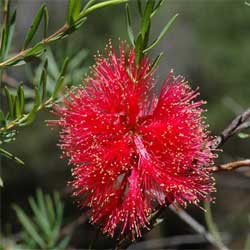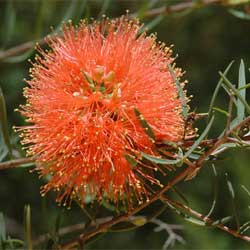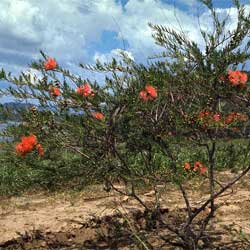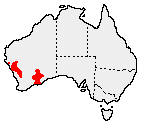Melaleuca fulgens
 |
 |
 |
Scarlet Honeymyrtle
Melaleuca fulgens, also known as the Scarlet Honeymyrtle, is a compact to straggly shrub with a round shape and slender branches. It occurs naturally in rocky granite areas of south Western Australia and has been successfully cultivated in the eastern States where it is particularly suited to coastal situations.
 Always
striking for its soft grey-green foliage, it is irresistible when in bloom
with yellow-tipped spikes of brush-like carmine flowers deep within the bush.
In Canberra the flowers are seen from October through to early winter.
Always
striking for its soft grey-green foliage, it is irresistible when in bloom
with yellow-tipped spikes of brush-like carmine flowers deep within the bush.
In Canberra the flowers are seen from October through to early winter.
The leaves are narrow, 2-3 cm long, and both leaves and branches give an aromatic fragrance when bruised. Birds, particularly honeyeaters searching for nectar, are attracted to the shrub when it is in flower.
In Canberra young plants need protection from low winter temperatures. Mature bushes are moderately frost hardy but tender tips and young flower buds can still be burned by sudden frosts, particularly when also hit by early morning sun. Some form of frost protection, certainly for young plants, should thus be considered. A suitable cover for a young plant is a hessian- or plastic-covered wire frame which can be easily removed. It is prudent to protect bushes from winds in the south-west quarter.
At the Australian National Botanic Gardens specimens which are eight years old are 1.5 m tall and 1.7 m wide. These came from seed sown in November and group-planted in neutral to slightly acid soil of sandy texture in open sun positions. Others planted beside existing shrubs grew to about 2.7 m in height but have a rangy, coarse appearance. Those planted in areas of filtered light are small and spindly with dull foliage.
Woody seed capsules which follow flowering provide plenty of propagation material. Propagation by soft tip cuttings is also practicable although the Australian National Botanic Gardens finds the seed method more rewarding. Generally this species can be bought at nurseries specialising in Australian native plants.
Melaleuca fulgens likes plenty of water and does not resent constantly damp positions. Nevertheless, good drainage should be encouraged as water-logged soil invites root rot diseases.
Pruning is not necessary, other than after flowering to control a desired shape. The shrub is generally free from pests but will benefit from periodic applications of a complete fertiliser.
Text by ANBG staff, 1977.
| Name meaning: Melaleuca fulgens Melaleuca - from the Greek, melas, black, and leukos, white, (the reason for the use of the name is obscure); fulgens - Latin, shining or bright-coloured, possibly referring to the bright carmine flower spikes |
![An Australian Government Initiative [logo]](/images/austgovt_brown_90px.gif)

